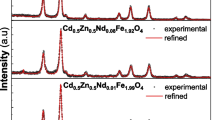Abstract
Susceptibility, magnetisation and Mössbauer measurements are reported for a representative selection of 2:1 layer phyllosilicates. Eight samples from the mica, vermiculite and smectite groups include examples diluted in iron which are paramagnetic at all temperatures, as well as iron-rich silicates which order magnetically below 10 K. Anisotropic susceptibility of crystals of muscovite, biotite and vermiculite is quantitatively explained with a model where the Fe2+ ions lie in sites of effective trigonal symmetry, the trigonal axis lying normal to the sheets. The ferrous ground state is an orbital singlet. Ferric iron gives an isotropic contribution to the susceptibility. Fe2+-Fe2+ exchange interactions are ferromagnetic with y ∼ 2 K, whereas Fe3+-Fe3+ coupling is antiferromagnetic in the purely ferric minerals. A positive paramagnetic Curie temperature for glauconite may be attributable to Fe2+ → Fe3+ charge transfer. Magnetic order was found to set in inhomogeneously for glauconite at 1–7 K. One biotite sample showed an antiferromagnetic transition at T N =7 K marked by a well-defined susceptibility maximum. Its magnetic structure, consisting of ferromagnetic sheets with moments in their planes coupled antiferromagnetically by other, weak interactions, resembles that found earlier for the 1:1 mineral greenalite.
Similar content being viewed by others
References
Anagnostopoulos T, Calamiotou M, Sideris C (1973) Magnetic behaviour of some biotite samples from Thrace, NE Greece. Clays Clay Miner 21:459–464
Annersten H (1974) Mössbauer studies of natural biotites. Am Mineral 59:143–151
Bailey SW (1980) Structures of layer silicates. In: Brindley GW, Brown G (eds) Crystal structures of clay minerals and their X-ray identification. London, Mineralogical Society, pp 1–124
Ballet O, Coey JMD, Massenet O (1979) Electric field gradient at Fe2+ sites is trioctahedral layer silicates. J Phys. (Paris) Colloq 40:C2 283–285
Beausoleil N, Lavallée P, Yelon A, Ballet O, Coey JMD (1982) Magnetic properties of biotite micas. J Appl Phys (in press)
Bleaney B, Stevens KWH (1953) Paramagnetic resonance. Rep Prog Phys 16:131–136
Bonnin D (1981) Thèse d'Etat, Université de Paris
Burns G (1970) Mineralogical applications of crystal field theory. Cambridge University Press, Cambridge
Coey JMD (1980) Clay minerals and their transformations studied with nuclear techniques: The contribution of Mössbauer spectroscopy. At Energy Rev 18:73–124
Coey JMD, Ballet O, Moukarika A, Soubeyroux JL (1981) Magnetic properties of sheets silicates; 1:1 layer minerals. Phys Chem Minerals 7:141–148
Crine JP, Friedmann A, Wertheimer MR, Yelon A (1977) The relationship between chemical composition and electrical conductivity of some North American micas. Can J Phys 55:270–275
Goodenough JB (1963) Magnetism and the chemical bond. Wiley Interscience, New York
Goodman BA (1976a) The Mössbauer spectrum of a ferrian muscovite and its implications in the assignment of sites in dioctahedral micas. Mineral Mag 40:513–517
Goodman BA (1976b) On the interpretations of Mössbauer spectra of biotites. Am Mineral 61:169
Goodman BA, Russell JD, Fraser AR, Woodhams FWD (1976), A Mössbauer and ir spectroscopic study of the structure of nontronite. Clays Clay Miner 24:53–59
Haggstrom L, Wappling R, Annersten H (1969) Mössbauer study of iron-rich biotites. Chem Phys Lett 4:107–108
Hutchings MT (1964) Point-charge calculations of energy levels of magnetic ions in crystalline electric fields. Solid State Phys 16:227–273
Martin DH (1967) Magnetism in solids. Iliffe Books, London
Pryce MHL (1950) A modified perturbation procedure for a problem in paramagnetism. Proc Roy Soc London Sect A 63:25–29
Rozenson I, Heller-Kallai L (1977) Mössbauer spectra of dioctahedral smectites. Clays Clay Miner 25:94–101
Rozenson I, Heller-Kallai L (1978) Mössbauer spectra of glauconites reexamined. Clays Clay Miner 26:173–175
Stryjewski E, Gordiano N (1977) Metamagnetism. Adv Phys 26:487–650
Varret F (1976) Crystal-field effects on high-spin ferrous ion. J Phys (Paris) Colloq 37:C6 437–456
Varret F, Hartmann-Boutron F (1968), Effets du couplage spin-orbite sur les propriétés des composés ioniques magnétiques du groupe du fer. Ann Phys (Paris) 3:57–174
Zener C (1951) Interaction between the d shells in the transition metals. Phys Rev 81:440–444
Author information
Authors and Affiliations
Rights and permissions
About this article
Cite this article
Ballet, O., Coey, J.M.D. Magnetic properties of sheet silicates; 2:1 layer minerals. Phys Chem Minerals 8, 218–229 (1982). https://doi.org/10.1007/BF00309481
Received:
Issue Date:
DOI: https://doi.org/10.1007/BF00309481




